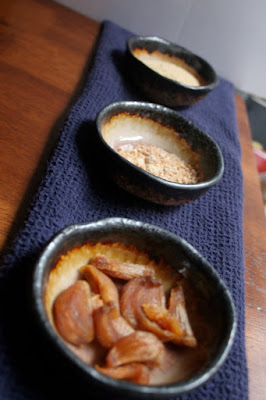My posts on
SousVide Supreme Chamber Vacuum and on the
Combi Oven nicely lead up to the subject of the value of the vacuum, and its role in low temperature cooking. For most home cooks exploring low temperature cooking, there are two primary reasons why you use vacuum sealed bags: heat transfer and eliminating buoyancy. Even though sous vide literally means under vacuum, you don't
need to

vacuum seal to achieve most of the desired affects of low temperature cooking. The truth is, you can use a ziplock bag, manually
remove the air out of the bag, and pretty much achieve both of these goals.

That being said, using a vacuum sealer is considerably more convenient. Especially if you are cooking products that tend to float or you are going to be using like 50 bags. Most consumers are familiar with the food saver style vacuum sealer. The foodsaver is an example of an external clamp vacuum sealer. These sealers suction the air out of a bag and then heat-seal. If your bag contains liquids, then you are likely to remove some liquid as well, which can affect the quality of the seal and also make a huge mess. There are ways to mitigate this, including freezing the liquids and double bagging, but they have their own challenges.

Chamber vacuums operate by placing your bag into the vacuum and putting the open end under a sealing bar. The vacuum sealer then removes all of the air from the entire chamber, including the bag. Since the air pressure stays equal both inside of the bag and outside (in the chamber), the liquid doesn't get sucked out of the bag.
At this point, you are probably wondering why someone would spend 700$ on a
chamber vacuum
when 130$ buys you an external clamp
vacuum sealer
. The truth is, there aren't that many cases where a chamber vacuum is essential for low temperature cooking techniques. Apart from the ability to vacuum liquids you can also control the strength of the vacuum. The vacuum strength can be used to influence the
texture of the product. The chamber vacuum is not just useful for sous vide, as it is also handy for other techniques, including: compression, rapid marination and infusion of liquids. While clamp vacuum sealers can sorta do some of those techniques, there are limitations, including lack of control and degrees of effectiveness.
 |
| Handy vacuum charts |
The distinction between vacuum sealer versus non-vacuum sealer is most important for commercial and professional kitchens, where the use of a vacuum may require an HACCP plan to minimize the risk of botulism or other food borne illnesses. This basically means that restaurants wanting to utilize modern low temperature cooking will have to take on a bunch of extra overhead, including additional process and inspections if a vacuum sealer is used.







This comment has been removed by a blog administrator.
ReplyDeleteDo all vacuum sealers use the same bags?
ReplyDeleteEach different brand of vacuum sealer has designed their machine to operate at a slightly different temperature, so using vacuum seal bags from other manufacturers can be problematic, as they may not seal properly or may melt creating a mess or causing damage. ... FoodSaver Bags are also universal.